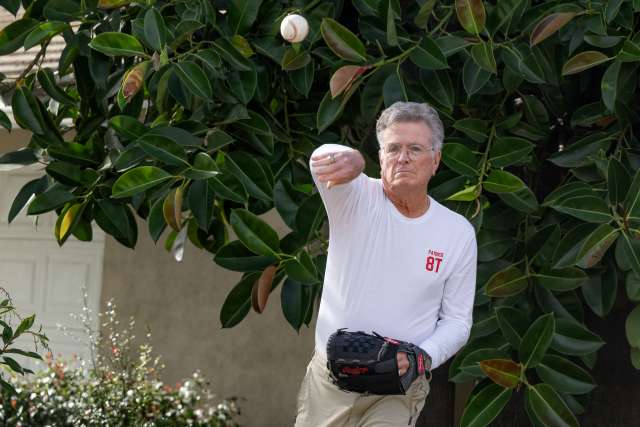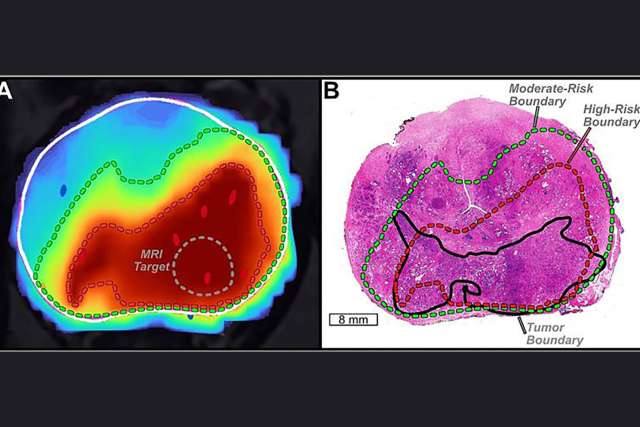At 80 years old, Patrick Schruben never thought he would be playing pickleball, doing push-ups and walking long distances, pain-free. The Westlake Village resident has been able to lead a physically active life after undergoing a minimally invasive genicular artery embolization (GAE) procedure for his knee in 2021, and then an elbow artery embolization (EAE) for his elbow in 2022.
With running long distances, cycling, and playing golf and tennis, Schruben was always exercising. But his athletic lifestyle also led to injuries throughout his life. He tore his meniscus on both knees and injured his rotator cuff on both arms – all of which were repaired with surgery.
Then, about three years ago, Schruben was experiencing pain on his right knee but wanted to pursue a treatment other than a knee replacement. “I did not want to sit in pain for months after surgery,” he says.
He found a YouTube video about GAE, and underwent the procedure in December of 2021.
Are you a candidate for genicular artery embolization?
Before GAE, Schruben could not get through a whole day of walking due to knee pain. After getting GAE, he was able to walk for long periods of time, virtually pain-free.
“That’s why my treatment was pretty amazing. I walked without knee pain the next day,” Schruben says.
During the GAE procedure, a catheter is inserted into the groin, and particles are injected into the inflamed arteries surrounding the knee joint; these particles alleviate pain by reducing blood flow to the targeted area.
While upward of 800,00 people get knee replacement annually, many people do not fit the criteria. They may have a medical condition that makes the surgery risky, they may be too young and prefer not to repeat the surgery in 20 years, or they may want to avoid the long recovery and rehabilitation time.
“It has been very disheartening to see so many patients who have experienced chronic joint pain over the years,” Siddharth Padia, MD, a UCLA interventional radiologist at UCLA Health, says. “That’s why it’s great that UCLA Health fine-tuned a quick, and straightforward procedure with effectively no recovery time.”
Undergoing the procedure also does not rule out the option to get a knee replacement if needed in the future.
From knees to elbows
Schruben also suffers from lateral epicondylitis, more commonly known as tennis elbow, thanks to years of repetitive motion from swinging a racket.
It all began in the 1940s, when he injured his right elbow from a fall at the age of 6. With no doctor around, he was given a sling, which caused his elbow to grow incorrectly. After a couple of surgeries, his elbow was fixed, and Schruben continued to regularly play racquetball and tennis. But over time, the pain in his elbow returned and he had to stop – a tragedy for someone who filled his days with climbing and golf.
A few years ago, he heard about pickleball, the fastest-growing sport in the U.S., and decided to pursue treatment options for his elbow other than getting routine steroid injections. The GAE procedure for his right knee went so well, he wanted to undergo the same procedure on his right elbow (EAE) – which he did in December of 2021.

Schruben now plays pickleball and does yard work a couple of times a week.
“Here I am at 80,” he says, “and I’m doing things my own children can’t do.”
Tennis elbow affects several thousand people in the U.S., according to Dr. Padia. In some cases, the condition is temporary, but in others, it can last for months or even years.
With the rapid popularity growth of pickleball, Dr. Padia says, cases have significantly increased: “We're starting to see a lot more people with tennis elbow than ever before.”
To meet the growing need for treatment, Dr. Padia turned to GAE for the elbow, now known as elbow artery embolization (EAE). A catheter is inserted into the wrist instead of the groin.
Ideal candidates for the procedure are patients who have persistent pain for three months, or those who have advanced tennis elbow and want to avoid the long recovery time that comes with surgery.
Schruben recovered in a week after the procedure. “With no elbow pain, I can do 40 push-ups a day,” he says. “And I’m really proud of that.”
Looking forward
When it comes to GAE for the knee, UCLA Health has treated the most patients in the country. Dr. Padia says Schruben is one of 290 patients who have received GAE on the knee at UCLA Health, and one of several dozen who have received EAE on the elbow.
Since the program opened in 2017, outcomes have been encouraging, Dr. Padia says. Few patients need physical therapy sessions or pain relief drugs.
Dr. Padia sees in GAE a potential treatment that other hospitals may eventually adopt. He is conducting an ongoing clinical trial on the benefits and drawbacks of GAE by collecting MRIs and retrieving fluid samples of the knee joint from two groups of people with osteoarthritis: those who have undergone the procedure and those who have not.
After his procedures, Schruben and his wife are looking forward to another year of traveling and walking. They visited Morocco in February and are going to India in the fall.
"The GAE and EAE procedures have opened up my last part of the life, athletically," he says.




